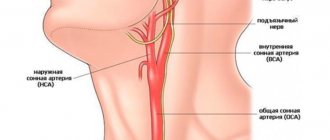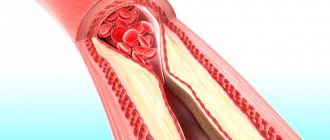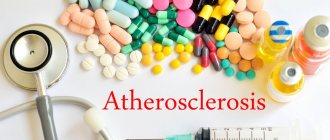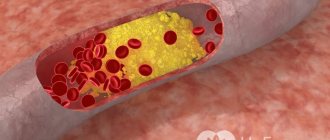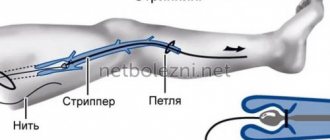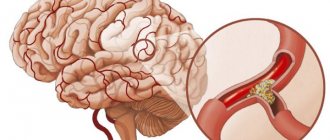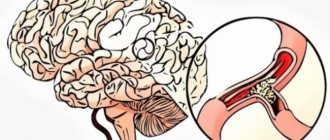Causes
Patients who have an increased number of platelets in the blood fall under the risk factor in the first place. Common causes of blood clot formation in the brain are hypertension and diabetes.
Constant stress and other negative effects on the mental state also have a negative impact.
Factors influencing the formation of compaction are:
- genetic predisposition;
- alcohol and tobacco abuse;
- passive lifestyle;
- obesity;
- meningitis;
- pathologies of the cardiovascular system;
- taking contraceptives.
As a rule, both internal and external factors can cause pathology.
Nonsteroidal anti-inflammatory drugs
To treat chronic venous insufficiency, phlebologists and vascular surgeons often prescribe nonsteroidal anti-inflammatory drugs (NSAIDs).
The mechanism of action of NSAIDs is to block the enzyme cyclooxygenase, thus stopping the breakdown of arachidonic acid and reducing the amount of pro-inflammatory agents.
Very often, varicose veins are combined with phlebitis, which can lead to thrombosis. NSAIDs fight inflammation, thus preventing the formation of blood clots. Despite the high effectiveness of NSAIDs, they have many side effects. During the breakdown of arachidonic acid, not only pro-inflammatory agents are released into the blood, but also substances that affect the regeneration of epithelium and nervous tissue.
The most common complication is gastritis or peptic ulcer. When taking NSAIDs, children may develop drug-induced hepatitis.
Contraindications:
- allergy to any of the components of the drug;
- gastritis and peptic ulcer;
- childhood;
- pregnancy and lactation;
- chronic liver and kidney failure.
Preventing thrombosis takes much less time and money than treating its complications. Treatment should be based on evidence-based medicine and carried out only according to the protocol under the supervision of the attending physician.
University: National Medical University named after academician A.A. Bogomolets.
Year of issue: 1999.
Specialization: surgery, proctology.
Experience:
Kyiv region, Vyshgorod central district hospital. May 2010 - August 2013.
How it develops
Thrombosis of cerebral vessels occurs due to the formation of a blood clot in the cavity of arterial or venous vessels, which prevents the free flow through the circulatory system, which is extremely important for this organ.
A common process for the formation of clots in the head is atherothrombosis, which occurs due to the layering of cholesterol on the walls of blood vessels. As it increases, it disrupts the integrity of the vessel, where platelets rush and the development of a blood clot begins.
Stages of development.
- Trauma to the internal cavity of the vessel.
- Manifestation of coagulation factors.
- Attachment of platelets to the damaged area.
- Isolation of the basis of clots - fibrin threads.
- A network of fibrin strands receives blood cells to form a clot.
- Compaction of formation.
The threat is not only from a detached blood clot, but also from a stationary one. However, in the first case, the likelihood of blockage increases significantly. The blood flow transports the clot to any organ, as a result of which the blood flow is blocked.
Anticoagulants
The pharmacological group of anticoagulants includes drugs that inhibit blood clotting processes. Anticoagulants are often prescribed to treat blood clots in blood vessels and prevent their occurrence.
Use of heparin for thrombosis
There are such groups of anticoagulants:
- anticoagulants with a direct effect on thrombin activity;
- anticoagulants with indirect action, affect the synthesis of thrombin in hepatocytes.
The basic medicine for thrombosis of the lower extremities is Heparin. The drug comes in all forms except tablets. Most ointments for the treatment and prevention of thrombosis include Heparin. This medication is a direct-acting anticoagulant.
The peculiarity of Heparin is that it irreversibly and quickly inhibits blood clotting factors. When using direct anticoagulants, platelets and prothrombin activation time should be examined every 24 hours.
Indirect anticoagulants are characterized by the fact that they affect the synthesis of blood clotting factors. The advantage of these drugs for thrombosis is that they are available in tablets.
Representatives of indirect anticoagulants are Warfarin and Sincumar. Indications for taking the drugs are acute deep vein thrombosis, coronary artery thrombosis, heart failure and myocardial infarction. Tablets for blood clots are taken in compliance with the dosage and monitoring of blood counts.
Read also: Gel for varicose veins reviews
Warfarin tablets for thrombosis
Contraindications to all anticoagulants are:
- bleeding;
- peptic ulcer;
- hemorrhagic stroke;
- DIC syndrome of the hypocoagulation stage;
- oncological diseases.
Classification
Thrombosis can be venous, arterial and venous sinus. The arterial appearance is typical for patients who have atherosclerosis. In this case, the following symptoms may occur:
- confusion;
- speech disorder;
- convulsions;
- numbness of the limbs.
Complete blockage of arterial vessels leads to ischemic stroke.
Often the walls of the blood vessels are not completely blocked, causing a blood clot to break off, which can transport it through the bloodstream to another organ and block blood access to it.
Venous thrombosis of the brain is characterized by severe dizziness, pain, blurred vision, and periodic vomiting in the morning. When the veins are completely blocked, a heart attack occurs, which leads to death.
Blood clots formed during inflammation of the paranasal sinuses cause thrombosis of the venous sinus.
The following symptoms are characteristic:
- headache;
- dizziness;
- vomit;
- nausea;
- swelling of the face and the appearance of a gray tint of the skin.
If the clot breaks off, blockage and swelling of the brain occurs. For this species, deaths are common.
When are medications prescribed?
The choice of medications for treatment should be made only by a doctor who supervises the underlying pathology. When choosing drugs for thrombosis, the following should be considered:
- the underlying disease that led to thrombosis;
- time when the blood clot occurred;
- patient's age;
- accompanying illnesses;
- the extent of damage from thrombosis of the lower extremities or internal organs;
- availability of alternatives to taking medications.
Drugs for the treatment of thrombosis are used not only in the event of acute conditions that threaten human life. There are a large number of indications for taking medicine for thrombosis.
Drugs for the treatment of thrombosis
Indications for taking medications for preventive and therapeutic purposes:
- varicose veins in advanced stages;
- heart failure;
- aneurysm of the aorta or other large vessels;
- atherosclerosis of peripheral and coronary vessels;
- myocardial infarction;
- ischemic cerebral stroke;
- pulmonary embolism;
- severe dehydration and blood thickening;
- DIC syndrome in the hypercoagulation stage.
In the event of acute thrombosis of vital organs, thrombolytics are the first-line drugs, but they are effective only in the first hour and a half.
The use of thrombolytics for thrombosis
The following groups of drugs are used to prevent thrombosis:
- anticoagulants;
- antiplatelet agents;
- phlebo- or venotonics;
- non-steroidal anti-inflammatory drugs (NSAIDs).
Prescribing drugs without appropriate indications can lead to the development of acute bleeding in internal organs!
The best option for preventing thrombosis is a combination of two drugs and lifestyle modifications.
Manifestations
A blood clot in the brain can manifest itself in different ways, and its symptoms appear gradually. The main sign that needs to be paid attention to is confusion. A person stops responding to external stimuli, he becomes sleepy, but is conscious.
Signs of the disease:
- headache;
- weakness, paralysis of part of the body;
- impaired coordination and speech;
- fainting.
The disease can occur in all ages, both in the elderly and in infants. However, it is not always possible to notice it with the naked eye; most often it is detected during a diagnostic examination of the patient.
Diagnostic methods
The need for research arises on the basis of clinical manifestations. When diagnosing, pay attention to swelling, pain and skin color. First, an external examination is carried out, then the patient’s blood pressure is measured. If a complication of the lungs occurs, an x-ray of paired organs is prescribed. The main diagnostic examinations are given in the table:
| Study | Why is it necessary? |
| Blood analysis | Determines accompanying pathological changes |
| Scanning of the venous system | Fixes the location of the blood clot and the path of its movement |
| Coagulogram | Determines blood clotting |
| Phlebography | Fixes the exact location of the blood clot |
| Angiography | Clarifies the diagnosis |
Possible complications
A blood clot in the brain is a dangerous condition that has life-threatening consequences. A blood clot in the head area can disrupt the functions of the brain.
As a result, an irreversible process will occur, which will cause significant damage to the organ and disruption of vital functions. Ultimately death occurs.
Consequences of thrombosis:
- development of cervical edema;
- cerebral infarction;
- paralysis of the musculoskeletal system;
- convulsions;
- impairment of vision, hearing, speech;
- inability to control bowel movements.
Antiplatelet agents
Drugs from the antiplatelet group are prescribed as additional medications for thrombosis of the lower extremities, heart failure, myocardial infarction and angina pectoris.
Antiplatelet agents improve the rheological properties of blood, block the release of thromboxane from platelets and reduce inflammation. There is an opinion that antiplatelet agents can provoke the resorption of blood clots.
Dipyridamole tablets for thrombosis
Indications for use:
- prevention of thrombosis;
- deep vein thrombosis of the lower extremities;
- thrombophlebitis and varicose veins;
- heart failure;
- ventricular fibrillation;
- myocardial infarction;
- hypertonic disease;
- angina pectoris.
The most common representative of this group is acetylsalicylic acid (ASA) or aspirin. ASA is a good medicine for thrombosis; it is included in many tablets and dietary supplements. ASA preparations are used in small doses of 150-300 mg. If the dosage is increased, the ability to inhibit platelets disappears.
Aspirin tablets for thrombosis
Drugs for the treatment of thrombosis that have a similar effect to Aspirin:
In order to reduce the negative effect on the gastrointestinal tract, protected antiplatelet agents are usually prescribed.
Contraindications:
- pregnancy and breastfeeding;
- gastritis and peptic ulcer;
- renal failure;
- bleeding and fresh wounds.
These medications should not be taken during pregnancy
Diagnostics
Cerebral thrombosis can be diagnosed while in the hospital, since this requires a number of measures:
- MRI;
- angiography;
- rheoencephalography;
- Doppler ultrasound.
Only after conducting a comprehensive study, the doctor determines the degree of development of the disease and prescribes appropriate treatment. If the disorder is discovered by chance, blood thinners are usually prescribed. You also need to give up bad habits, because otherwise drug treatment will be ineffective.
Phlebotonics
Thrombosis of the lower extremities in 60% of cases is a complication of varicose veins. To treat dilated veins, various ointments, gels and tablets with a venotonic effect are used.
Phlebotonics include:
- Detralex. The tablets improve the strength of the venous wall and restore its elasticity. Take one tablet twice a day, every 10-12 hours;
- Phlebodia. The action of the drug is aimed at relieving swelling and heaviness from the lower extremities. Treatment lasts no more than 2 months; to treat varicose veins, take one tablet twice a day;
- Antistax. The drug increases the tone of the veins and improves the functioning of their valves. It consists of medicinal plants and is well tolerated by patients;
- Reaprid. Available in gel form for topical use, it improves blood circulation and prevents varicose veins.
To prevent thrombosis, several types of drugs should be prescribed, for example, ointments and tablets for thrombosis. If varicose veins develop during pregnancy, treatment should be safe for the fetus.
Who's at risk
Currently, thrombosis affects more than half of the world's population. The risk group includes the following categories of people.
- People prone to obesity.
- Men whose age is over 40 years old, since the blood composition does not renew.
- People who adhere to an unbalanced diet, a sedentary lifestyle, as well as alcohol and tobacco abuse.
Thrombosis is a disease that can affect anyone, but it does not have characteristic symptoms in the initial stages. Because of this, opportunities to improve your health are unintentionally missed.
Therefore, eliminating risk factors is a top priority to help maintain health.
The material was prepared specifically for the website venaprof.ru, edited by doctor N.A. Glushakova. Specialty: therapy, cardiology, family medicine.
Treatment
Treatment methods are adjusted depending on the form and type of the disease. Therapeutic techniques involve obtaining the desired effect for various tasks:
- Detoxification.
- Elimination of swelling from the head.
- Liquefaction of blood clots.
- Neuroprotective treatment.
- Elimination of infectious inflammations.
Conservative procedures are always performed based on the medications used, since fatal outcome must be prevented. Many antibiotics are used to detoxify and eliminate harmful microbes from the circulatory system. Infusion solutions are used to quickly get rid of toxins.
Antibiotics are prescribed only as a result of blood cultures. This makes it possible to determine the resistance of the infection to certain substances. Before this, products with a broad spectrum of action are used. Antiplatelet agents help prevent the formation of thrombosis.
Diuretics are used when there is a threat of swelling. If we consider neuroprotective therapy, it is better to use it during the recovery process. For these purposes, vasodilators are used.
Medicines that eliminate blood clots prevent the secondary occurrence of blood clots. In the process of thrombosis without suppuration, this technique helps prevent disability .
Heparin is often used under the control of a coagulogram until clinical signs are eliminated. This remedy is used for 7-10 days. After this, Warfarin is prescribed for 2-3 months, which is an indirect anticoagulant. For the purpose of maintenance therapy, Aspirin or Curantil is used for a long time. Heparin is being replaced by low molecular weight analogues, which have a weaker effect and safety.
For seizures, a course of treatment with Depakine or Valproate is prescribed for 6-12 months. Increased intracranial pressure is eliminated by osmatic diuretics.
Migraines should not be treated with hormonal or non-steroidal drugs, since their use increases the likelihood of new blood clots.
To stabilize the condition, a cerebrospinal fluid puncture and an intravenous injection of Heparin are performed. Surgeries are rarely performed if the immune system is not activated after medication. Surgical intervention is difficult because it is not easy to sanitize the sinuses due to the anatomy of the skull. In such situations, the paranasal sinuses are opened, then the location of the primary infections is sanitized.
Opening the source of inflammation is performed for: sinusitis, mastoiditis, abscess. For problems with the functioning of consciousness based on increased intracranial pressure with poor effectiveness of conservative treatment, patients may be recommended craniotomy and removal of the blood clot.
This technique is dangerous due to postoperative complications, so this method is used in rare cases.
